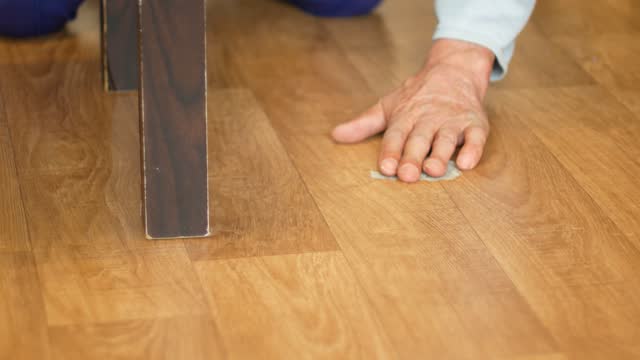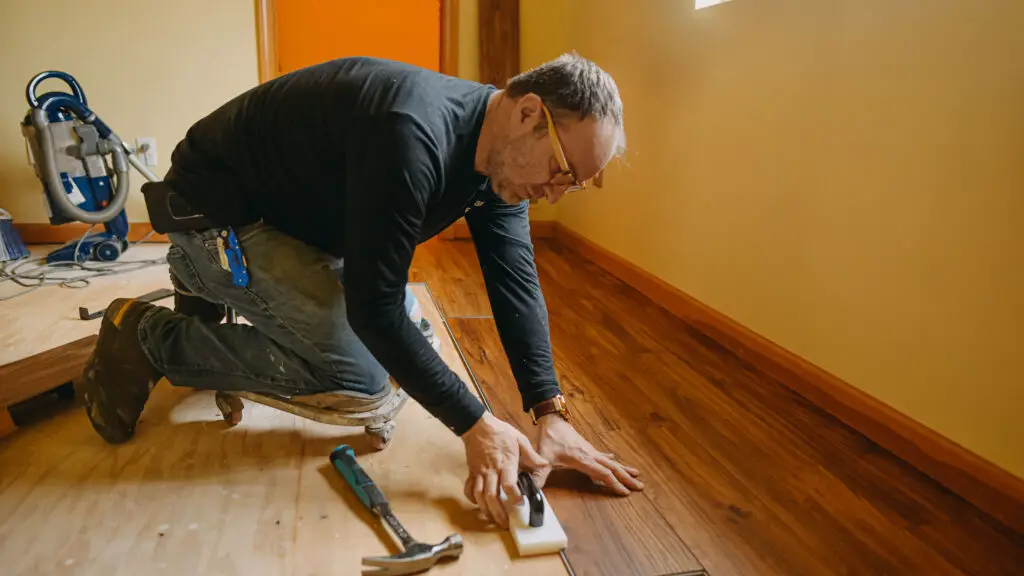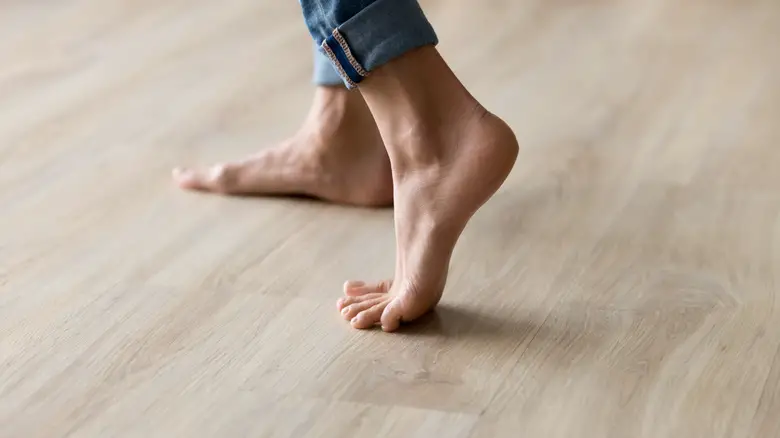Laminate flooring is a popular choice for many homeowners due to its durability and aesthetic appeal. However, one common issue often encountered is the annoying and potentially dangerous movement of the laminate floor when it’s walked on.
This guide is designed to help you understand and implement strategies to effectively stop laminate flooring from moving when walked on, ensuring a safe and stable walking surface in your home.
The issue of laminate floors moving when walked upon can be a pervasive and disruptive problem for homeowners. This movement is not only annoying, creating an unstable and noisy surface, but can also pose a safety risk, increasing the potential for slips and trips.
The root cause of this issue lies primarily in the installation process of the laminate flooring. Factors such as poor subfloor preparation, inadequate acclimatization of laminate planks before installation, or incorrect placement of underlayment can contribute to the subsequent movement of the laminate flooring.
Understanding these underlying factors is the first step in implementing effective solutions.
Reasons Why Laminate Floors Move

Improper Installation
Improper installation is one of the leading causes of laminate floors moving when walked on. This usually stems from a few common errors made during the installation process.
Firstly, failing to properly prepare the subfloor can lead to uneven surfaces, causing the laminate planks to shift and move underfoot. The subfloor must be thoroughly cleaned and leveled before placing the laminate.
Furthermore, neglecting to properly acclimatize the laminate planks to the room’s temperature and humidity can cause them to expand or contract post-installation, resulting in movement.
Another key mistake during installation is the incorrect placement or absence of underlayment. Underlayment serves as a cushion between the subfloor and the laminate, absorbing any minor imperfections of the subfloor and reducing the movement of the laminate.
Quality of the Underlayment
The quality of underlayment is a crucial factor in preventing laminate floors from moving. It’s not just about having an underlayment, but also about its quality and compatibility with your flooring.
The underlayment needs to be dense and thick enough to withstand pressure without being overly compressible. If the underlayment is too thin or made from low-quality materials, it won’t provide sufficient cushioning, leading to increased movement of the laminate flooring.
Moreover, the underlayment should possess good moisture-resisting properties to prevent any potential water damage.
Always opt for a high-quality underlayment that meets the specifications of your laminate flooring manufacturer to ensure optimal performance and longevity of your floors.
Room Temperature and Humidity
The effect of room temperature and humidity on laminate flooring cannot be overstated. Laminate floors are susceptible to the ambient conditions of the room in which they’re installed.
Changes in temperature and humidity can cause the laminate planks to expand and contract, leading to movement when they’re walked upon. Therefore, it’s critical to maintain a consistent temperature and humidity level in the room.
The laminate should also be left in the room where it will be installed for at least 48 hours before installation to properly acclimatize.
This acclimatization process allows the planks to adapt to the room’s specific environmental conditions, minimizing any subsequent expansion or contraction post-installation.
Investing in a good quality humidifier or dehumidifier, depending on your local climate, can also aid in controlling the room’s humidity levels, further ensuring the stability of your laminate flooring.
Wear and Tear Over Time
Over time, all laminate floors inevitably experience wear and tear due to foot traffic, furniture movement, and the occasional spill. This wear and tear can cause the laminate to move when walked on, especially if the protective surface layer becomes worn down.
This surface layer is responsible for maintaining the structural integrity of the laminate, and its degradation can lead to increased flexibility and movement in the flooring.
Therefore, it’s crucial to promptly clean up spills, use furniture pads, and avoid dragging heavy items across the surface to reduce wear and tear. Regular maintenance, such as routine cleaning with appropriate laminate floor cleaners and avoiding abrasive scrubbing tools, can also extend the life of your laminate flooring.
Additionally, consider investing in high-quality laminate flooring with a high wear rating, which indicates its ability to withstand a higher degree of foot traffic and other forms of wear.
Consequences of Moving Laminate Floors

Noise and Discomfort
When laminate floors move when walked on, this can result in two significant issues: noise and discomfort. The noise usually manifests as a squeaking or creaking sound, which can be quite disruptive, especially in quiet environments.
This is often caused by friction between the moving planks and can be exacerbated if the subfloor is not perfectly level or if the underlayment has degraded over time.
Discomfort can also be an issue as the instability of the flooring can make walking or standing uncomfortable.
This can be particularly problematic in areas where you spend a lot of time standing, such as the kitchen. Over time, this discomfort can contribute to fatigue and other physical discomforts, diminishing the overall enjoyment and usability of the space.
Damage to the flooring
The frequent movement of laminate floors, when walked on, can eventually lead to severe structural damage. This typically manifests in the form of chips, cracks, or, in extreme cases, complete dislodging of the laminate planks.
This type of damage is not only unsightly, compromising the aesthetic appeal of your space, but also hazardous as it can create trip hazards.
Moreover, any gaps left by damaged or dislodged planks can expose the underlying subfloor, making it susceptible to moisture and other forms of damage. Consequently, this can necessitate costly and time-consuming repairs or replacement of the entire floor.
Potential Safety Hazards
Laminate floors that move when walked on can also pose various safety hazards, particularly in homes with elderly individuals or children. The inconsistent floor surface can increase the risk of slips and falls, leading to potential injuries.
Especially if the laminate planks become severely damaged or dislodged, they can create a tripping hazard. In addition to the immediate risk of physical injury, these conditions could also contribute to a sense of unease or insecurity when walking on the floor, particularly for those with mobility issues.
Furthermore, the exposed subfloor due to damaged planks could potentially harbor harmful mold and bacteria if exposed to moisture, posing health risks.
Methods to Prevent Laminate Floors from Moving

Proper Installation Techniques
One of the most effective ways to prevent laminate floors from moving is to ensure they are properly installed from the outset. Adequate preparation of the subfloor is critical; it should be level, clean, and dry.
While installing, leave an expansion gap around the perimeter of the room to accommodate any natural expansion and contraction of the laminate material due to changes in humidity and temperature. This will minimize movement and potential damage.
Moreover, using a good quality underlayment can also help stabilize the laminate flooring. It not only provides a cushion between the subfloor and the laminate but also adds a moisture barrier, reducing the risk of warping.
Locking the laminate planks together securely is also crucial. Many laminate floors feature a click-lock design for easy installation, but it’s essential to ensure that all planks are locked together tightly to prevent movement.
Lastly, consider the use of moldings and transitions where the laminate meets other types of flooring or fixed objects, as these can help to keep the laminate flooring in place.
Quality Underlay Selection
Choosing a high-quality underlay is paramount in preventing laminate floors from moving. The underlay serves as a buffer, absorbing the stress and strain of foot traffic and heavy furniture, thereby reducing the risk of movement.
A superior underlay should excel in providing sound insulation, comfort underfoot, and most importantly, stability to the laminate flooring.
Underlays come in many types, including foam, cork, and felt, each with its unique properties. Foam underlays, for instance, are lightweight and easy to install, offering good insulation properties.
Cork underlays are naturally resistant to mold, mildew, and pests, making them an environmentally friendly choice. Felt underlays, on the other hand, offer superior sound absorption and durability.
To select the best underlay, consider the specific needs of your space, the type of subfloor, and the manufacturer’s recommendations for the laminate flooring.
Maintaining the Right Room Temperature and Humidity
Optimal room temperature and humidity are essential for maintaining the stability of laminate flooring. Laminates are sensitive to their environment and can warp or shrink in response to extreme temperatures or humidity levels.
The ideal room temperature for laminate floors is generally between 60 – 80 degrees Fahrenheit (15 – 26 degrees Celsius), and humidity levels should be kept between 30 – 60 percent.
Sudden fluctuations in temperature and humidity should be avoided. Thus, it is advisable to use a reliable thermostat and humidifier to maintain a stable indoor climate.
Air conditioning during hot, humid summers and humidifiers during dry winters can help keep the conditions optimal.
Moreover, try not to expose laminate floors to direct sunlight for prolonged periods, as this can cause the laminate to expand and contract, leading to damage. Using blinds, curtains, or other window coverings can help protect the laminate flooring from direct sun exposure.
Regular Floor Care and Maintenance
Proper care and maintenance are fundamental to prolonging the life and appearance of laminate floors. Regular sweeping or vacuuming can remove surface dirt and debris, preventing them from scratching or damaging the laminate surface.
When vacuuming, use a brush attachment to avoid causing scratches.
For deeper cleaning, use a damp mop with a laminate floor cleaner, but avoid excessive water as it can seep into the seams of the flooring and cause damage. It’s important to immediately clean up any spills to prevent staining or warping of the laminate material.
In high-traffic areas, consider using rugs or mats to protect the laminate surface from wear and tear. However, ensure these are non-rubber backed as rubber can discolor laminate flooring.
Lastly, avoid dragging heavy furniture across the floor to prevent dents and scratches. If necessary, use furniture pads under the legs of heavy items to distribute the weight evenly and prevent damage to the laminate.
Related Topics:
Conclusion
In conclusion, ensuring the stability of your laminate flooring doesn’t have to be a difficult task. With proper installation, the right underlayment, and effective control of room temperature and humidity, you can significantly reduce the movement of laminate floors when walked on.
It’s also crucial to carry out regular floor care and maintenance to keep your laminate flooring in prime condition, reducing wear and tear that could lead to movement.
By following these guidelines, you can enjoy a safe, stable, and long-lasting laminate floor that enhances the beauty and comfort of your home.
FAQs
What type of underlayment is best for reducing laminate floor movement?
The choice of underlayment can significantly impact the stability of your laminate flooring. A dense, solid underlayment like rubber or foam is usually a good choice as it can absorb the pressure of foot traffic and reduce floor movement. Additionally, an underlayment with a moisture barrier is recommended if you’re installing over a concrete subfloor to prevent moisture-related issues, which can also cause movement.
Can the way I install my laminate flooring affect its stability?
Yes, the installation method can indeed influence the stability of laminate floors. It’s recommended to leave a small expansion gap around the perimeter of the room during installation. This allows the floor to expand and contract with changes in humidity and temperature without causing buckling or movement when walked on.

1 thought on “How to Stop Laminate Floors from Moving When Walked On”